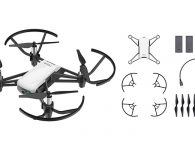

With Apple reaching the end of its current three-year product cycle, we aren’t expected to get a brand new iPhone redesign until 2020. But that doesn’t mean the new iPhone 11 isn’t packing some important upgrades like Apple’s first triple camera module, a faster A13 chip (and a new motion co-processor) and some clever new photo modes, along with a batch of fresh new color options.
So let’s dive in and explore all the new changes and additions Apple has included on the iPhone 11.
Models
Like last year, Apple’s new lineup of iPhones is split between three models: the 6.1-inch iPhone 11, along with the 5.8-inch iPhone 11 Pro and 6.5-inch iPhone 11 Pro Max, the latter two being Apple’s new high-end flagship phones.
The iPhone 11 will be available in white, yellow, green, purple, black, and red. The iPhone 11 Pro will be available in midnight green, space gray, silver, and a new shade of gold.
Performance and Design
Featuring the new 7nm A13 Bionic processor, Apple claims the iPhone 11 has the fastest CPU and GPU in any smartphone, boasting 20 percent faster processing and 20 percent better graphics performance, along with a neural processing engine that’s 20 percent faster than the A12 Bionic.
However, one nice addition to the new iPhone lineup is support for Wi-Fi 6, which should allow for faster wireless networking, especially when paired with some of the next-gen third-party routers slated for release later this fall.
As for the iPhone 11 Pro’s construction, Apple says it’s using a new combination of stainless steel and a matte glass panel in back. In fact, Apple is touting a bunch of other small improvements like stronger glass, better water-resistance, faster charging, a brighter overall display, and more.
Cameras and Photos
For the standard iPhone 11, Apple has moved up to a 12-MP dual camera setup with primary and ultra-wide lenses. Additionally, Apple says it has updated its photo processing pipeline with semantic rendering, which makes it easier to adjust lighting on the fly.
Meanwhile the iPhone 11 Pro will come with a third 12-MP 2x telephoto camera to create Apple’s first triple rear camera module
When it comes to new photo abilities, Apple’s portrait mode has been upgraded to work with the iPhone 11’s wide-angle lens, and it even works on pets too. But perhaps the biggest upgrade is that the Apple has finally given the iPhone a dedicated Night Mode that can improve the quality and focus of low-light photos. Depending on the environment, the iPhone will adjust settings like ISO and shutter speed while using OIS in order to capture the sharpest, brightest photo possible.
As for video, Apple is supporting a bunch of different modes and formats including 4K video at 60 fps, slo-mo capture, time-lapse, cinematic video stabilization, and extended dynamic range, regardless if you’re using the main or ultra-wide cameras. And in front, you can even use that slo-mo feature to take slo-mo selfies.
Finally, using a new technique call Deep Fusion, the iPhone 11 Pro will be able to shoot nine pictures in quick succession, and then utilize its neural engine to create a new composite image that contains the best aspects of each underlying pic.
Battery Life
For 2019, Apple claims the iPhone 11 will last an hour longer than last year’s iPhone XR. But the big upgrade in longevity will come with the iPhone 11 Pro, which boasts an extra four hours of battery life compared to last year’s iPhone XS.
Price and Availability
Surprisingly, the iPhone 11 will cost $50 less than than last year’s iPhone XR, with a starting price of $700.
But if you’re interested in the iPhone 11 Pro and iPhone 11 Pro Max, you’ll have to shell out significantly more at $1,000 and $1,100, respectively.
All three phones will be available for pre-order starting Friday, September 13th, with shipments expected to go out on September 20th.
read more at https://gizmodo.com by Sam Rutherford
Tech








